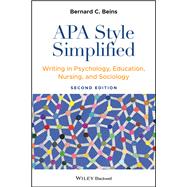Master the fundamentals of 7th Edition APA style with this newly updated one-step resource
The newly and thoroughly revised Second Edition of APA Style Simplified: Writing in Psychology, Education, Nursing, and Sociology delivers a concise but comprehensive guide to writing clearly and effectively in APA style. It incorporates fresh guidelines from the Seventh Edition of the APA publication manual.
Distinguished psychologist, academic, and author Dr. Bernard C. Beins walks readers through how to write objective scientific research papers using engaging prose. He explains how to develop ideas, connect them to what others have written, and express them clearly. The book also describes the differences between written, oral, and poster presentations and offers instructions for applying APA style to each one.
APA Style Simplified: Writing in Psychology, Education, Nursing, and Sociology 2nd Edition goes beyond mere structural conventions and teaches readers the importance of choosing effective wording, the right and wrong times to use technical language, and avoiding commonly encountered mistakes in word and sentence selection. The author also includes sections on:
- How to write an engaging and informative introduction, including an interesting hypothesis
- How to describe your chosen experimental method, including participants and subjects, materials and apparatus selection, procedure, and design
- How to effectively communicate statistics and statistical concepts by keeping your mind on the point you’re trying to make
- How to show your results and relate them back to your hypothesis, including a few points about how to present your results to others
Perfect for students pursuing psychology, education, nursing, or sociology programs at any level, from undergraduate to postgraduate, APA Style Simplified also belongs on the bookshelves of working professionals in the same fields who hope to sharpen their APA-style writing, communication, and presentation skills.








